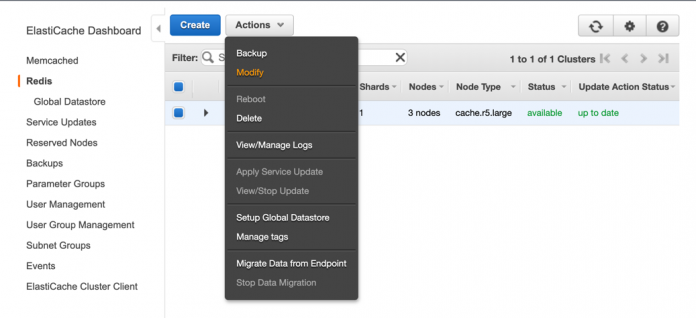In late 2020, we announced the availability of Amazon ElastiCache for Redis and Memcached on Graviton2 M6g and R6g instance families. These instances offer a 45% better price/performance improvement over previous generation instances. They’re based on AWS-designed AWS Graviton2 processors using 64-bit Arm Neoverse N1 cores. ElastiCache for Redis enhanced I/O handling, Global Datastore, and all other ElastiCache for Redis features are supported on Graviton2 instances with no client-side changes required. Graviton2 instances are now the default choice for ElastiCache customers.
The Graviton2 instance family includes several new performance optimizations, including larger L1 and L2 caches per core, fully encrypted RAM, and more. You can benefit from these optimizations with minimal effort by provisioning or migrating your ElastiCache instances today. You can do this for Redis 5.06 and higher and Memcached 1.15.16 and higher. In this blog post, you will learn about the performance benefits of Graviton2 instances and how to migrate your ElastiCache for Redis cluster to Graviton2.
Performance analysis
We ran the redis-benchmark utility with random 512 bytes fixed keys, 80% gets, 20% sets, and 80% hit ratio on an ElastiCache for Redis 6.0.5 cluster with one shard and zero replicas.
With 800 client connections, we saw up to 57% better performance. The following table summarizes the results.
Node Size
M5 node
M6g Node
Performance Gain
large
161,000 RPS
187,000 RPS
16%
xlarge
199,500 RPS
314,500 RPS
57%
2xlarge
299,000 RPS
318,000 RPS
6%
4xlarge
310,000 RPS
317,000 RPS
2%
Migrate an ElastiCache for Redis cluster to Graviton2
Migrating to Graviton 2 instances is easy. To use the ElastiCache console, complete the following steps:
Sign in to the AWS Management Console and open the Amazon ElastiCache console
On the ElastiCache console, select your ElastiCache for Redis cluster.
On the Actions menu, choose Modify.
For Node Type, choose a node type in the R6g or M6g family (the “g” stands for Graviton2).
By default, Apply immediately is selected.
Deselect Apply immediately to modify your cluster node type during the next maintenance window.
During this process, your cluster continues to serve requests with minimal downtime.
Choose Modify.
Or, using the AWS Command Line Interface (AWS CLI), you can use the modify-cache-cluster –cache-node-type API call.
You can provision new or migrate to Graviton2 ElastiCache instances in all Regions where Amazon Elastic Compute Cloud (Amazon EC2) M6g and R6g are available:
US East (Ohio)
US East (N. Virginia)
US West (N. California)
US West (Oregon)
Asia Pacific (Mumbai)
Asia Pacific (Singapore)
Asia Pacific (Sydney)
Asia Pacific (Tokyo)
Europe (Ireland)
Europe (Frankfurt)
Conclusion
In this post, we demonstrated the performance improvements of ElastiCache on Graviton2 M6g and R6g instance families. You can create or upgrade seamlessly to Graviton2-based instances today using the ElastiCache console, AWS CLI, or ElastiCache API.
If you have any questions or feedback, reach out on the Amazon ElastiCache Discussion Forum or in the comments.
About the Authors
Scott Bell, Sr. Solutions Architect, AWS.
Zach Gardner, Sr. ElastiCache Solutions Architect, AWS.
Asaf Porat Stoler, Software Development Manager, AWS.
Yaron Sananes, Software Development Manager, AWS.
Read MoreAWS Database Blog


